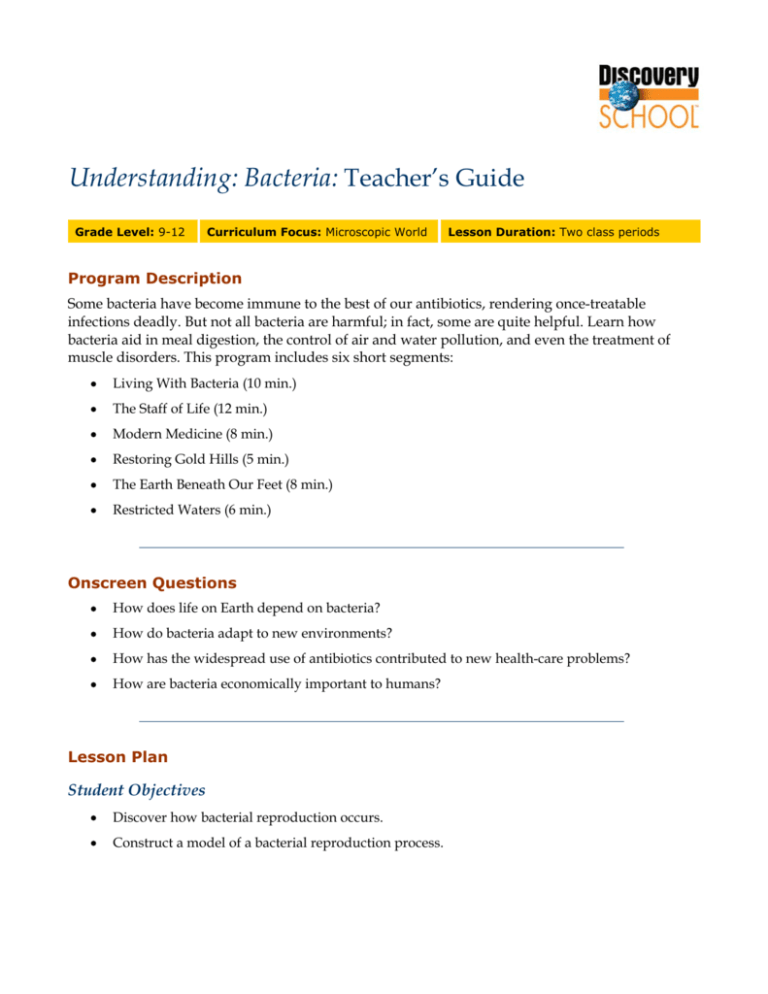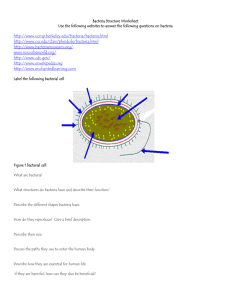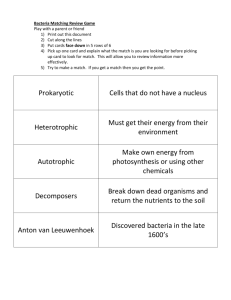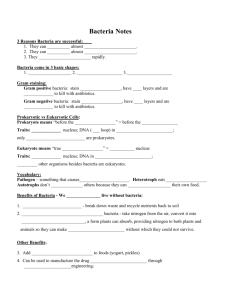
Understanding: Bacteria: Teacher’s Guide
Grade Level: 9-12
Curriculum Focus: Microscopic World
Lesson Duration: Two class periods
Program Description
Some bacteria have become immune to the best of our antibiotics, rendering once-treatable
infections deadly. But not all bacteria are harmful; in fact, some are quite helpful. Learn how
bacteria aid in meal digestion, the control of air and water pollution, and even the treatment of
muscle disorders. This program includes six short segments:
•
Living With Bacteria (10 min.)
•
The Staff of Life (12 min.)
•
Modern Medicine (8 min.)
•
Restoring Gold Hills (5 min.)
•
The Earth Beneath Our Feet (8 min.)
•
Restricted Waters (6 min.)
Onscreen Questions
•
How does life on Earth depend on bacteria?
•
How do bacteria adapt to new environments?
•
How has the widespread use of antibiotics contributed to new health-care problems?
•
How are bacteria economically important to humans?
Lesson Plan
Student Objectives
•
Discover how bacterial reproduction occurs.
•
Construct a model of a bacterial reproduction process.
Understanding: Bacteria: Teacher’s Guide
2
Materials
•
Understanding: Bacteria video and VCR, or DVD and DVD player
•
Library or Internet resources on bacteria and bacterial reproduction
•
Computer with Internet access
•
Clay for constructing models
•
Paper and pens or pencils
Procedures
1. Review what students have learned about cell reproduction, concentrating on reproduction in
bacteria.
2. Using print materials and the Internet, have students research bacterial reproduction. Instruct
them to take careful notes and make diagrams as they conduct their research.
3. In class, encourage students to share their research findings. Make sure they have discovered
that bacterial reproduction may occur asexually (by a form of cell division called fission) or
sexually (by a transfer of genetic material from a donor bacterium to a recipient).
4. Have each student construct a clay model that illustrates one process of bacterial reproduction.
The models should be labeled clearly.
5. Then, ask students to write a paragraph that identifies and clearly describes the process they’ve
illustrated with their model. You may wish to extend the project by having students write
additional paragraphs that compare and contrast bacterial reproduction with mitotic
reproduction in a single human cell.
6. Review students’ models and paragraphs as a class, asking the following questions:
•
How do bacteria differ from other single-celled organisms?
•
How do bacteria compare to viruses?
•
What are some beneficial uses of bacterial toxins in medicine?
•
How do bacteria change and adapt to new environments?
•
Why is genetic research an important part of understanding microorganisms?
•
How can we protect ourselves daily from contamination by pathogenic
microorganisms?
Assessment
Use the following three-point rubric to evaluate students’ work during this lesson.
•
3 points: Students accurately constructed and clearly labeled their model; wrote an accurate,
complete, and clear paragraph.
Published by Discovery Education. © 2005. All rights reserved.
Understanding: Bacteria: Teacher’s Guide
•
2 points: Students adequately constructed and labeled their model; wrote an accurate but
incomplete and unclear paragraph.
•
1 point: Students inadequately constructed and labeled their model; wrote an incomplete,
unclear, and inaccurate paragraph.
3
Vocabulary
culture medium
Definition: A nutrient system for the artificial cultivation of cells or organisms, especially
bacteria
Context: Many types of bacteria can be grown on a culture medium.
enzyme
Definition: Any of various complex proteins produced by living cells that bring about or
accelerate reactions (such as the digestion of food) at body temperatures without being
permanently altered
Context: For a microbe to consume food from its environment, it must make enzymes that break
down the food into usable molecules.
microbiology
Definition: A branch of biology focused on microscopic forms of life
Context: Advances in microbiology have helped identify many types of bacteria.
microorganism
Definition: An organism of microscopic or ultramicroscopic size
Context: Microorganisms range from bacteria that help us digest food to the pathogens that
make us sick.
mutate
Definition: To change the physical relation of chromosomes or the genetic sequence in an
organism
Context: Bacteria mutate to adapt to new conditions in their environment.
pathogen
Definition: An organism that causes disease
Context: Pathogens such as salmonella and streptococcus may cause great suffering.
Academic Standards
National Academy of Sciences
The National Science Education Standards provide guidelines for teaching science as well as a
coherent vision of what it means to be scientifically literate for students in grades K-12. To view the
standards, visit http://books.nap.edu.
Published by Discovery Education. © 2005. All rights reserved.
Understanding: Bacteria: Teacher’s Guide
4
This lesson plan addresses the following science standards:
•
Life Science: Biological evolution; Interdependence of organisms; Behavior of organisms
Mid-continent Research for Education and Learning (McREL)
McREL’s Content Knowledge: A Compendium of Standards and Benchmarks for K-12 Education
addresses 14 content areas. To view the standards and benchmarks, visit http://www.mcrel.org/.
This lesson plan addresses the following national standards:
•
Science—Life Sciences: Understands the structure and function of cells and organisms
•
Language Arts—Viewing: Uses viewing skills and strategies to understand and interpret
visual media; Reading: Uses reading skills and strategies to understand and interpret a
variety of informational texts
Support Materials
Develop custom worksheets, educational puzzles, online quizzes, and more with the free teaching tools
offered on the Discoveryschool.com Web site. Create and print support materials, or save them to a
Custom Classroom account for future use. To learn more, visit
•
http://school.discovery.com/teachingtools/teachingtools.html
DVD Content
This program is available in an interactive DVD format. The following information and activities are
specific to the DVD version.
How To Use the DVD
The DVD starting screen has the following options:
Play Video—This plays the video from start to finish. There are no programmed stops, except by
using a remote control. With a computer, depending on the particular software player, a pause
button is included with the other video controls.
Video Index—Here the video is divided into six parts (see below), indicated by video thumbnail
icons. Watching all parts in sequence is similar to watching the video from start to finish. Brief
descriptions and total running times are noted for each part. To play a particular segment, press
Enter on the remote for TV playback; on a computer, click once to highlight a thumbnail and read
the accompanying text description and click again to start the video.
Curriculum Units—These are specially edited video segments pulled from different sections of the
video (see below). These nonlinear segments align with key ideas in the unit of instruction. They
include onscreen pre- and post-viewing questions, reproduced below in this Teacher’s Guide. Total
Published by Discovery Education. © 2005. All rights reserved.
Understanding: Bacteria: Teacher’s Guide
5
running times for these segments are noted. To play a particular segment, press Enter on the TV
remote or click once on the Curriculum Unit title on a computer.
Standards Link—Selecting this option displays a single screen that lists the national academic
standards the video addresses.
Teacher Resources—This screen gives the technical support number and Web site address.
Video Index
I. Living With Bacteria (10 min.)
Found all around us, bacteria are the smallest living organisms that can survive without a host cell.
Learn about helpful and harmful bacteria.
II. The Staff of Life (12 min.)
Some bacteria make our food taste good, others may make us deathly ill. Discover the secret behind
sourdough bread, and learn about the potentially deadly E. coli bacteria.
III. Modern Medicine (8 min.)
Antibiotics have become a medical staple. But are bacteria smarter than our drugs? Investigate the
global increase in antibiotic resistance.
IV. Restoring Gold Hills (5 min.)
See how a bacterium helped solve a major environmental problem in a small mining town.
V. The Earth Beneath Our Feet (8 min.)
Billions of different bacterial microorganisms live on Earth. Some are economically and
environmentally important to humans. Explore the world of microorganisms with scientists and
experts.
VI. Restricted Waters (6 min.)
Water pollution is a growing threat. Learn about water pollution, and visit a paper factory that is
working to keep our planet clean.
Curriculum Units
1. Infectious Disease
Pre-viewing question
Q: What are some things you do to protect yourself from getting bacterial infections?
A: Answers will vary.
Post-viewing question
Q: What would happen if we rid the world of bacteria?
A: Answers will vary.
Published by Discovery Education. © 2005. All rights reserved.
Understanding: Bacteria: Teacher’s Guide
6
2. Good and Bad Bacteria
Pre-viewing question
Q: Are all bacteria harmful?
A: No. There are many different types of bacteria, and only about one percent cause disease.
Post-viewing question
Q: What are some ways good bacteria help keep us healthy?
A: E. coli, a type of bacteria found in our digestive tract, help turn our food into sugars and
processed vitamins.
3. Using Deadly Bacteria
Pre-viewing question
Q: What are the dangers of experimenting with deadly bacteria?
A: Answers will vary.
Post-viewing question
Q: What medical conditions do scientists hope botulinum will help?
A: Research shows that botulinum might eventually help millions of people suffering from
conditions associated with hyperactive muscles, including Parkinson’s disease, cerebral palsy, and
multiple sclerosis.
4. Bread and Cheese
Pre-viewing question
Q: What foods contain bacteria?
A: Answers will vary.
Post-viewing question
Q: How are bacteria used in making cheese?
A: Bacteria are used to give cheese different flavors and, in the case of Swiss cheese, to create the
holes.
5. Streptococcus and E. coli
Pre-viewing question
Q: How can you reduce the risk of bad bacteria in your food?
A: Properly clean and cook all meat and fish, store perishable foods in the refrigerator, check the
expiration dates on dairy and meat products, and clean and disinfect anything used to prepare raw
meat and fish.
Post-viewing question
Q: How does E. coli poisoning occur?
A: A strain of E. coli that lives in cow intestines can be transferred to people if the animal parts are
not properly cleaned and separated before the meat is processed. Adequate cooking will kill the E.
coli, but if the meat is not properly cooked, people can become very ill.
Published by Discovery Education. © 2005. All rights reserved.
Understanding: Bacteria: Teacher’s Guide
6. The Wonder Drug
Pre-viewing question
Q: For what purposes do we use antibiotics?
A: Answers will vary.
Post-viewing question
Q: Why have some antibiotics stopped working as effectively?
A: Bacteria are able to adapt as they reproduce. In some cases, they have changed to the point
where they can resist certain antibiotics’ attempts to kill them.
7. Antibiotics and Children
Pre-viewing question
Q: Are antibiotics always the answer for curing illnesses?
A: No, viruses and some illnesses cannot be cured with antibiotics.
Post-viewing question
Q: Do you think antibiotics are overly prescribed?
A: Answers will vary.
8. An All-Purpose Medicine
Pre-viewing question
Q: Why are antibiotics given to farm animals?
A: They are given to cows, pigs, and even fish to help prevent bacteria and to increase their size,
which means more meat to sell.
Post-viewing question
Q: Should antibiotics be given to animals and sprayed on fruits and vegetables?
A: Answers will vary.
9. Resisting Medication
Pre-viewing question
Q: What do you think would happen if all antibiotics stopped working?
A: Answers will vary.
Post-viewing question
Q: What has caused an increased resistance to some antibiotics throughout the world?
A: Answers will vary. Possible answers include an increase in general mobility and the overuse of
antibiotics.
10. Cleaning Up the Cyanide
Pre-viewing question
Q: How does mining hurt the environment?
A: Answers will vary.
Published by Discovery Education. © 2005. All rights reserved.
7
Understanding: Bacteria: Teacher’s Guide
8
Post-viewing question
Q: Is it risky to introduce foreign bacteria into an environment for cleaning purposes?
A: Answers will vary.
11. Making Enzymes
Pre-viewing question
Q: What are enzymes used for?
A: Answers will vary.
Post-viewing question
Q: Why is enzyme production such a big industry?
A: Enzymes are used in many major industries because they provide safer or less expensive ways to
make a product. For example, in the paper industry, enzymes provide an environmentally friendly
way to whiten paper without the use of toxic chemicals.
12. Testing the Soil
Pre-viewing question
Q: What is a microorganism?
A: The oldest life form on Earth, these organisms are too small to be seen with the human eye; in
fact, some are too small to be seen with a microscope. Also known as microbes, they include
viruses, bacteria, fungi, protozoa, algae, and nematodes.
Post-viewing question
Q: Do you think the bacteria that live on Earth exist on other planets?
A: Answers will vary.
13. Understanding Water Pollution
Pre-viewing question
Q: What are some human activities that cause water pollution?
A: Answers will vary.
Post-viewing question
Q: How can we decrease the amount of pollutants in our water?
A: Answers will vary.
Published by Discovery Education. © 2005. All rights reserved.










